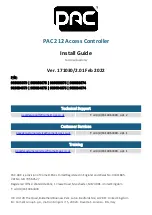
CPU Overview
The Central Processing Unit is the heart of the PLC. Almost all
system operations are controlled by the CPU, so it is important
that it is set-up and installed correctly. This chapter provides the
information needed to understand:
• The differences between the various models of CPUs
• The steps required to setup and install the CPU
General CPU Features
The DL230, DL240, DL250–1 and D2–260 are modular CPUs
which can be installed in 3, 4, 6, or 9 slot bases. All I/O modules
in the DL205 family will work with any of the CPUs. The
DL205 CPUs offer a wide range of processing power and program instructions. All offer RLL
and Stage program instructions (See Chapter 5). They also provide extensive internal
diagnostics that can be monitored from the application program or from an operator
interface.
DL230 CPU Features
The DL230 has 2.4K words of memory comprised of 2.0K of ladder memory and
approximately 400 words of V-memory (data registers). It has 92 different instructions
available for programming, and supports a maximum of 256 I/O points.
Program storage is in the factory-installed EEPROM. In addition to the EEPROM there is
also RAM on the CPU which will store system parameters, V-memory, and other data which
is not in the application program.
The DL230 provides one built-in RS-232 communication port, so you can easily connect a
handheld programmer or a personal computer without needing any additional hardware.
DL240 CPU Features
The DL240 has a maximum of 3.8K of memory comprised of 2.5K of ladder memory and
approximately 1.3K of V-memory (data registers). There are 129 instructions available for
program development and a maximum of 256 points local I/O and 896 points with remote
I/O are supported.
Program storage is in the factory-installed EEPROM. In addition to the EEPROM there is
also RAM on the CPU which will store system parameters, V-memory and other data which
is not in the application program.
The DL240 has two communication ports. The top port is the same port configuration as the
DL230. The bottom port also supports the
Direct
NET protocol, so you can use the DL240
in a
Direct
NET network. Since the port is RS-232, you must use an RS-232/RS-422
converter for multi-drop connections.
DL205 User Manual, 4th Edition, Rev. B
3–2
Chapter 3: CPU Specifications and Operations
1
2
3
4
5
6
7
8
9
10
11
12
13
14
A
B
C
D
















































